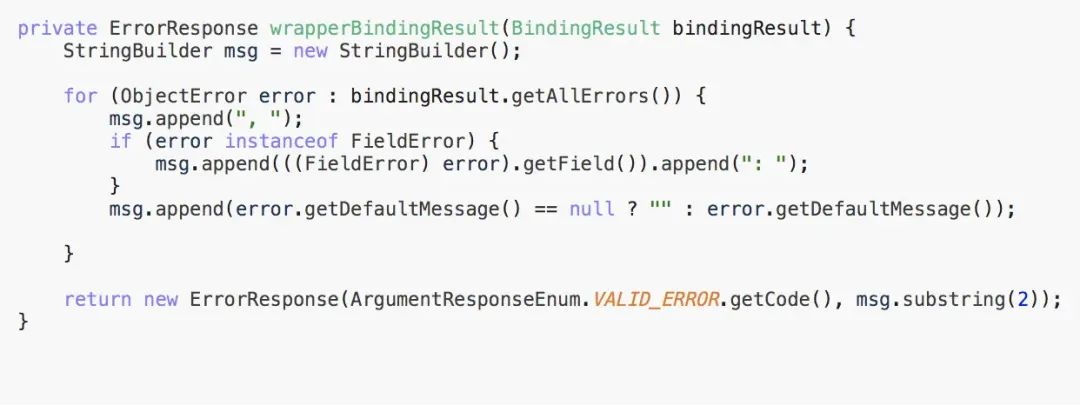try catch !
点击关注公众号:互联网架构师,后台回复 2T获取2TB学习资源!
背景
丑陋的 try catch 代码块
优雅的Controller
什么是统一异常处理
注意到上面对异常按阶段进行分类,大体可以分成:进入Controller前的异常 和Service 层异常,具体可以参考下图:
不同阶段的异常
目标
消灭95%以上的 try catch 代码块,以优雅的 Assert(断言) 方式来校验业务的异常情况,只关注业务逻辑,而不用花费大量精力写冗余的 try catch 代码块。
统一异常处理实战
在定义统一异常处理类之前,先来介绍一下如何优雅的判定异常情况并抛异常。
用 Assert(断言) 替换 throw exception
想必 Assert(断言) 大家都很熟悉,比如 Spring 家族的org.springframework.util.Assert,在我们写测试用例的时候经常会用到,使用断言能让我们编码的时候有一种非一般丝滑的感觉,比如:
@Testpublic void test1() {...User user = userDao.selectById(userId);Assert.notNull(user, "用户不存在.");...}@Testpublic void test2() {// 另一种写法User user = userDao.selectById(userId);if (user == null) {throw new IllegalArgumentException("用户不存在.");}}
public abstract class Assert {public Assert() {}public static void notNull(@Nullable Object object, String message) {if (object == null) {throw new IllegalArgumentException(message);}}}
Assert
public interface Assert {/*** 创建异常* @param args* @return*/BaseException newException(Object... args);/*** 创建异常* @param t* @param args* @return*/BaseException newException(Throwable t, Object... args);/*** <p>断言对象<code>obj</code>非空。如果对象<code>obj</code>为空,则抛出异常** @param obj 待判断对象*/default void assertNotNull(Object obj) {if (obj == null) {throw newException(obj);}}/*** <p>断言对象<code>obj</code>非空。如果对象<code>obj</code>为空,则抛出异常* <p>异常信息<code>message</code>支持传递参数方式,避免在判断之前进行字符串拼接操作** @param obj 待判断对象* @param args message占位符对应的参数列表*/default void assertNotNull(Object obj, Object... args) {if (obj == null) {throw newException(args);}}}
看到这里,您可能会有这样的疑问,按照上面的说法,那岂不是有多少异常情况,就得有定义等量的断言类和异常类,这显然是反人类的,这也没想象中高明嘛。别急,且听我细细道来。
善解人意的Enum
public interface IResponseEnum {int getCode();String getMessage();}/*** <p>业务异常</p>* <p>业务处理时,出现异常,可以抛出该异常</p>*/public class BusinessException extends BaseException {private static final long serialVersionUID = 1L;public BusinessException(IResponseEnum responseEnum, Object[] args, String message) {super(responseEnum, args, message);}public BusinessException(IResponseEnum responseEnum, Object[] args, String message, Throwable cause) {super(responseEnum, args, message, cause);}}public interface BusinessExceptionAssert extends IResponseEnum, Assert {@Overridedefault BaseException newException(Object... args) {String msg = MessageFormat.format(this.getMessage(), args);return new BusinessException(this, args, msg);}@Overridedefault BaseException newException(Throwable t, Object... args) {String msg = MessageFormat.format(this.getMessage(), args);return new BusinessException(this, args, msg, t);}}@Getter@AllArgsConstructorpublic enum ResponseEnum implements BusinessExceptionAssert {/*** Bad licence type*/BAD_LICENCE_TYPE(7001, "Bad licence type."),/*** Licence not found*/LICENCE_NOT_FOUND(7002, "Licence not found.");/*** 返回码*/private int code;/*** 返回消息*/private String message;}
看到这里,有没有眼前一亮的感觉,代码示例中定义了两个枚举实例:
/*** 校验{@link Licence}存在* @param licence*/private void checkNotNull(Licence licence) {ResponseEnum.LICENCE_NOT_FOUND.assertNotNull(licence);}
若不使用断言,代码可能如下:
private void checkNotNull(Licence licence) {if (licence == null) {throw new LicenceNotFoundException();// 或者这样throw new BusinessException(7001, "Bad licence type.");}}
注:上面举的例子是针对特定的业务,而有部分异常情况是通用的,比如:服务器繁忙、网络异常、服务器异常、参数校验异常、404等,所以有CommonResponseEnum、ArgumentResponseEnum、ServletResponseEnum,其中ServletResponseEnum 会在后文详细说明。
定义统一异常处理器类
@Slf4j@Component@ControllerAdvice@ConditionalOnWebApplication@ConditionalOnMissingBean(UnifiedExceptionHandler.class)public class UnifiedExceptionHandler {/*** 生产环境*/private final static String ENV_PROD = "prod";@Autowiredprivate UnifiedMessageSource unifiedMessageSource;/*** 当前环境*/@Value("${spring.profiles.active}")private String profile;/*** 获取国际化消息** @param e 异常* @return*/public String getMessage(BaseException e) {String code = "response." + e.getResponseEnum().toString();String message = unifiedMessageSource.getMessage(code, e.getArgs());if (message == null || message.isEmpty()) {return e.getMessage();}return message;}/*** 业务异常** @param e 异常* @return 异常结果*/@ExceptionHandler(value = BusinessException.class)@ResponseBodypublic ErrorResponse handleBusinessException(BaseException e) {log.error(e.getMessage(), e);return new ErrorResponse(e.getResponseEnum().getCode(), getMessage(e));}/*** 自定义异常** @param e 异常* @return 异常结果*/@ExceptionHandler(value = BaseException.class)@ResponseBodypublic ErrorResponse handleBaseException(BaseException e) {log.error(e.getMessage(), e);return new ErrorResponse(e.getResponseEnum().getCode(), getMessage(e));}/*** Controller上一层相关异常** @param e 异常* @return 异常结果*/@ExceptionHandler({NoHandlerFoundException.class,HttpRequestMethodNotSupportedException.class,HttpMediaTypeNotSupportedException.class,MissingPathVariableException.class,MissingServletRequestParameterException.class,TypeMismatchException.class,HttpMessageNotReadableException.class,HttpMessageNotWritableException.class,// BindException.class,// MethodArgumentNotValidException.classHttpMediaTypeNotAcceptableException.class,ServletRequestBindingException.class,ConversionNotSupportedException.class,MissingServletRequestPartException.class,AsyncRequestTimeoutException.class})@ResponseBodypublic ErrorResponse handleServletException(Exception e) {log.error(e.getMessage(), e);int code = CommonResponseEnum.SERVER_ERROR.getCode();try {ServletResponseEnum servletExceptionEnum = ServletResponseEnum.valueOf(e.getClass().getSimpleName());code = servletExceptionEnum.getCode();} catch (IllegalArgumentException e1) {log.error("class [{}] not defined in enum {}", e.getClass().getName(), ServletResponseEnum.class.getName());}if (ENV_PROD.equals(profile)) {// 当为生产环境, 不适合把具体的异常信息展示给用户, 比如404.code = CommonResponseEnum.SERVER_ERROR.getCode();BaseException baseException = new BaseException(CommonResponseEnum.SERVER_ERROR);String message = getMessage(baseException);return new ErrorResponse(code, message);}return new ErrorResponse(code, e.getMessage());}/*** 参数绑定异常** @param e 异常* @return 异常结果*/@ExceptionHandler(value = BindException.class)@ResponseBodypublic ErrorResponse handleBindException(BindException e) {log.error("参数绑定校验异常", e);return wrapperBindingResult(e.getBindingResult());}/*** 参数校验异常,将校验失败的所有异常组合成一条错误信息** @param e 异常* @return 异常结果*/@ExceptionHandler(value = MethodArgumentNotValidException.class)@ResponseBodypublic ErrorResponse handleValidException(MethodArgumentNotValidException e) {log.error("参数绑定校验异常", e);return wrapperBindingResult(e.getBindingResult());}/*** 包装绑定异常结果** @param bindingResult 绑定结果* @return 异常结果*/private ErrorResponse wrapperBindingResult(BindingResult bindingResult) {StringBuilder msg = new StringBuilder();for (ObjectError error : bindingResult.getAllErrors()) {msg.append(", ");if (error instanceof FieldError) {msg.append(((FieldError) error).getField()).append(": ");}msg.append(error.getDefaultMessage() == null ? "" : error.getDefaultMessage());}return new ErrorResponse(ArgumentResponseEnum.VALID_ERROR.getCode(), msg.substring(2));}/*** 未定义异常** @param e 异常* @return 异常结果*/@ExceptionHandler(value = Exception.class)@ResponseBodypublic ErrorResponse handleException(Exception e) {log.error(e.getMessage(), e);if (ENV_PROD.equals(profile)) {// 当为生产环境, 不适合把具体的异常信息展示给用户, 比如数据库异常信息.int code = CommonResponseEnum.SERVER_ERROR.getCode();BaseException baseException = new BaseException(CommonResponseEnum.SERVER_ERROR);String message = getMessage(baseException);return new ErrorResponse(code, message);}return new ErrorResponse(CommonResponseEnum.SERVER_ERROR.getCode(), e.getMessage());}}
可以看到,上面将异常分成几类,实际上只有两大类,一类是ServletException、ServiceException,还记得上文提到的 按阶段分类 吗,即对应 进入Controller前的异常 和 Service 层异常;然后 ServiceException 再分成自定义异常、未知异常。对应关系如下:
进入Controller前的异常: handleServletException、handleBindException、handleValidException
自定义异常: handleBusinessException、handleBaseException
未知异常: handleException
接下来分别对这几种异常处理器做详细说明。
异常处理器说明
handleServletException
NoHandlerFoundException:首先根据请求Url查找有没有对应的控制器,若没有则会抛该异常,也就是大家非常熟悉的404异常;
HttpRequestMethodNotSupportedException:若匹配到了(匹配结果是一个列表,不同的是http方法不同,如:Get、Post等),则尝试将请求的http方法与列表的控制器做匹配,若没有对应http方法的控制器,则抛该异常;
HttpMediaTypeNotSupportedException:然后再对请求头与控制器支持的做比较,比如content-type请求头,若控制器的参数签名包含注解@RequestBody,但是请求的content-type请求头的值没有包含application/json,那么会抛该异常(当然,不止这种情况会抛这个异常);
MissingPathVariableException:未检测到路径参数。比如url为:/licence/{licenceId},参数签名包含@PathVariable("licenceId"),当请求的url为/licence,在没有明确定义url为/licence的情况下,会被判定为:缺少路径参数;
MissingServletRequestParameterException:缺少请求参数。比如定义了参数@RequestParam("licenceId") String licenceId,但发起请求时,未携带该参数,则会抛该异常;
TypeMismatchException: 参数类型匹配失败。比如:接收参数为Long型,但传入的值确是一个字符串,那么将会出现类型转换失败的情况,这时会抛该异常;
HttpMessageNotReadableException:与上面的HttpMediaTypeNotSupportedException举的例子完全相反,即请求头携带了"content-type: application/json;charset=UTF-8",但接收参数却没有添加注解@RequestBody,或者请求体携带的 json 串反序列化成 pojo 的过程中失败了,也会抛该异常;
HttpMessageNotWritableException:返回的 pojo 在序列化成 json 过程失败了,那么抛该异常;
HttpMediaTypeNotAcceptableException:未知;
ServletRequestBindingException:未知;
ConversionNotSupportedException:未知;
MissingServletRequestPartException:未知;
AsyncRequestTimeoutException:未知;
handleBindException
参数校验异常,后文详细说明。
handleValidException
参数校验异常,后文详细说明。
handleBusinessException、handleBaseException
处理自定义的业务异常,只是handleBaseException处理的是除了 BusinessException 意外的所有业务异常。就目前来看,这2个是可以合并成一个的。
handleException
处理所有未知的异常,比如操作数据库失败的异常。
注:上面的handleServletException、handleException 这两个处理器,返回的异常信息,不同环境返回的可能不一样,以为这些异常信息都是框架自带的异常信息,一般都是英文的,不太好直接展示给用户看,所以统一返回SERVER_ERROR代表的异常信息。
异于常人的404
上文提到,当请求没有匹配到控制器的情况下,会抛出NoHandlerFoundException异常,但其实默认情况下不是这样,默认情况下会出现类似如下页面:

Whitelabel Error Page
这个页面是如何出现的呢?实际上,当出现404的时候,默认是不抛异常的,而是forward跳转到/error控制器,spring也提供了默认的error控制器,如下:
BasicErrorController
那么,如何让404也抛出异常呢,只需在properties文件中加入如下配置即可:
spring.mvc.throw-exception-if-no-handler-found=true
spring.resources.add-mappings=false
如此,就可以异常处理器中捕获它了,然后前端只要捕获到特定的状态码,立即跳转到404页面即可
捕获404对应的异常
统一返回结果
验证统一异常处理
因为这一套统一异常处理可以说是通用的,所有可以设计成一个 common包,以后每一个新项目/模块只需引入该包即可。所以为了验证,需要新建一个项目,并引入该 common包。项目结构如下:
项目结构
以后只需这样引入即可
引入common包
主要代码
下面是用于验证的主要源码:
@Servicepublic class LicenceService extends ServiceImpl<LicenceMapper, Licence> {@Autowiredprivate OrganizationClient organizationClient;/*** 查询{@link Licence} 详情* @param licenceId* @return*/public LicenceDTO queryDetail(Long licenceId) {Licence licence = this.getById(licenceId);checkNotNull(licence);OrganizationDTO org = ClientUtil.execute(() -> organizationClient.getOrganization(licence.getOrganizationId()));return toLicenceDTO(licence, org);}/*** 分页获取* @param licenceParam 分页查询参数* @return*/public QueryData<SimpleLicenceDTO> getLicences(LicenceParam licenceParam) {String licenceType = licenceParam.getLicenceType();LicenceTypeEnum licenceTypeEnum = LicenceTypeEnum.parseOfNullable(licenceType);// 断言, 非空ResponseEnum.BAD_LICENCE_TYPE.assertNotNull(licenceTypeEnum);LambdaQueryWrapper<Licence> wrapper = new LambdaQueryWrapper<>();wrapper.eq(Licence::getLicenceType, licenceType);IPage<Licence> page = this.page(new QueryPage<>(licenceParam), wrapper);return new QueryData<>(page, this::toSimpleLicenceDTO);}/*** 新增{@link Licence}* @param request 请求体* @return*/@Transactional(rollbackFor = Throwable.class)public LicenceAddRespData addLicence(LicenceAddRequest request) {Licence licence = new Licence();licence.setOrganizationId(request.getOrganizationId());licence.setLicenceType(request.getLicenceType());licence.setProductName(request.getProductName());licence.setLicenceMax(request.getLicenceMax());licence.setLicenceAllocated(request.getLicenceAllocated());licence.setComment(request.getComment());this.save(licence);return new LicenceAddRespData(licence.getLicenceId());}/*** entity -> simple dto* @param licence {@link Licence} entity* @return {@link SimpleLicenceDTO}*/private SimpleLicenceDTO toSimpleLicenceDTO(Licence licence) {// 省略}/*** entity -> dto* @param licence {@link Licence} entity* @param org {@link OrganizationDTO}* @return {@link LicenceDTO}*/private LicenceDTO toLicenceDTO(Licence licence, OrganizationDTO org) {// 省略}/*** 校验{@link Licence}存在* @param licence*/private void checkNotNull(Licence licence) {ResponseEnum.LICENCE_NOT_FOUND.assertNotNull(licence);}}
ps: 这里使用的DAO框架是mybatis-plus。
启动时,自动插入的数据为:
-- licenceINSERT INTO licence (licence_id, organization_id, licence_type, product_name, licence_max, licence_allocated)VALUES (1, 1, 'user','CustomerPro', 100,5);INSERT INTO licence (licence_id, organization_id, licence_type, product_name, licence_max, licence_allocated)VALUES (2, 1, 'user','suitability-plus', 200,189);INSERT INTO licence (licence_id, organization_id, licence_type, product_name, licence_max, licence_allocated)VALUES (3, 2, 'user','HR-PowerSuite', 100,4);INSERT INTO licence (licence_id, organization_id, licence_type, product_name, licence_max, licence_allocated)VALUES (4, 2, 'core-prod','WildCat Application Gateway', 16,16);-- organizationsINSERT INTO organization (id, name, contact_name, contact_email, contact_phone)VALUES (1, 'customer-crm-co', 'Mark Balster', 'mark.balster@custcrmco.com', '823-555-1212');INSERT INTO organization (id, name, contact_name, contact_email, contact_phone)VALUES (2, 'HR-PowerSuite', 'Doug Drewry','doug.drewry@hr.com', '920-555-1212');
开始验证
捕获自定义异常
获取不存在的 licence 详情:http://localhost:10000/licence/5。成功响应的请求:licenceId=1

校验非空
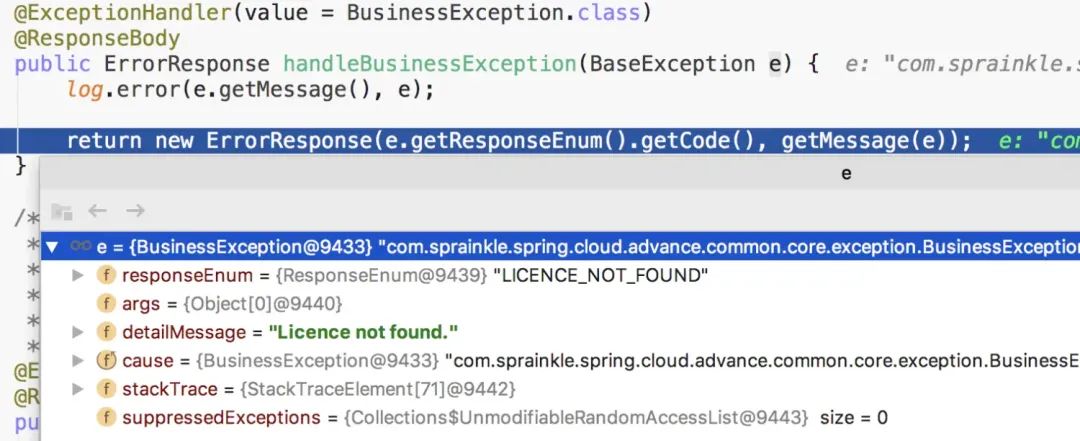
捕获 Licence not found 异常

Licence not found
2.根据不存在的 licence type 获取 licence 列表:http://localhost:10000/licence/list?licenceType=ddd。可选的 licence type 为:user、core-prod 。

校验非空

捕获 Bad licence type 异常
捕获进入 Controller 前的异常
访问不存在的接口:http://localhost:10000/licence/list/ddd
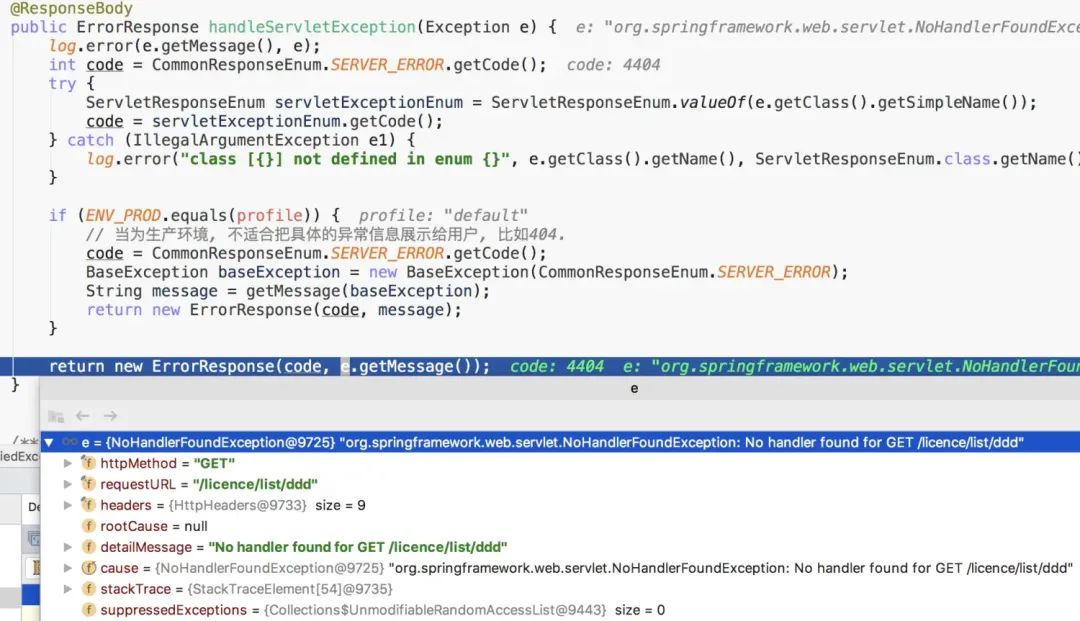
捕获404异常
http 方法不支持:http://localhost:10000/licence
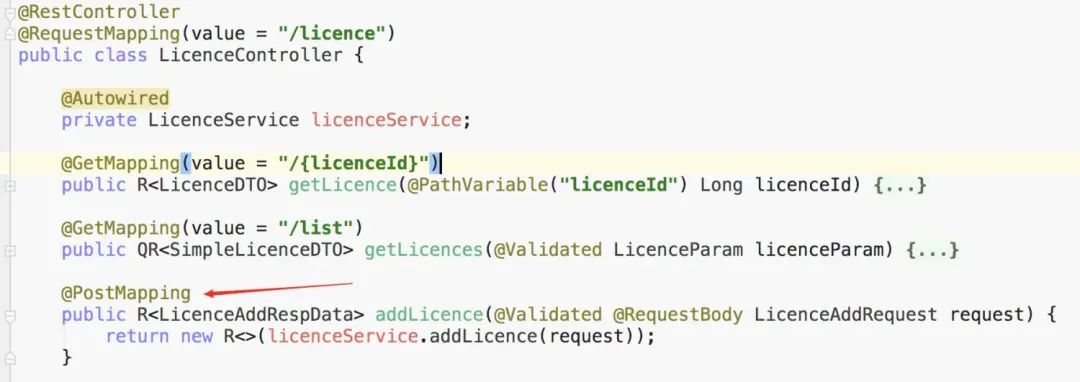
PostMapping
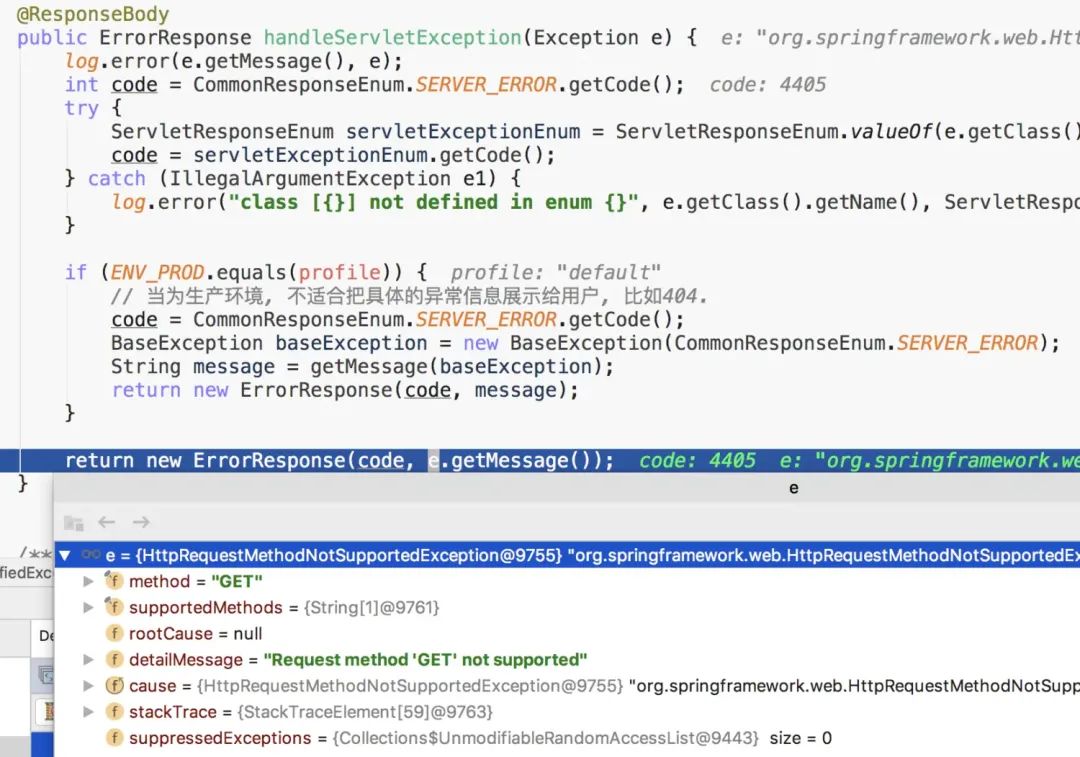
捕获 Request method not supported 异常

Request method not supported
3 校验异常1:http://localhost:10000/licence/list?licenceType=

getLicences

LicenceParam
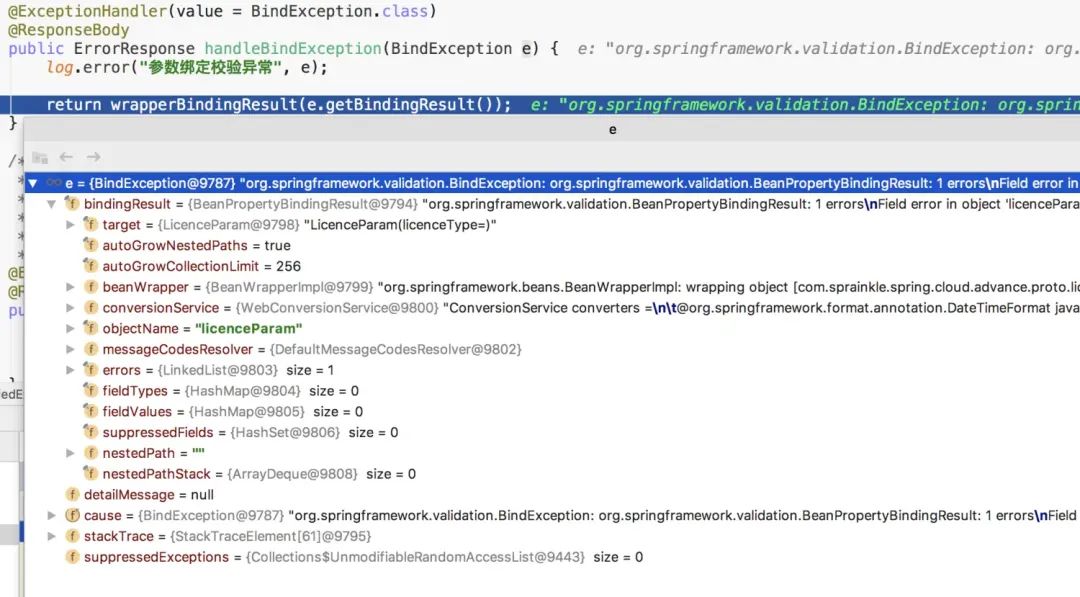
捕获参数绑定校验异常

licence type cannot be empty
4.校验异常2:post 请求,这里使用postman模拟。

addLicence
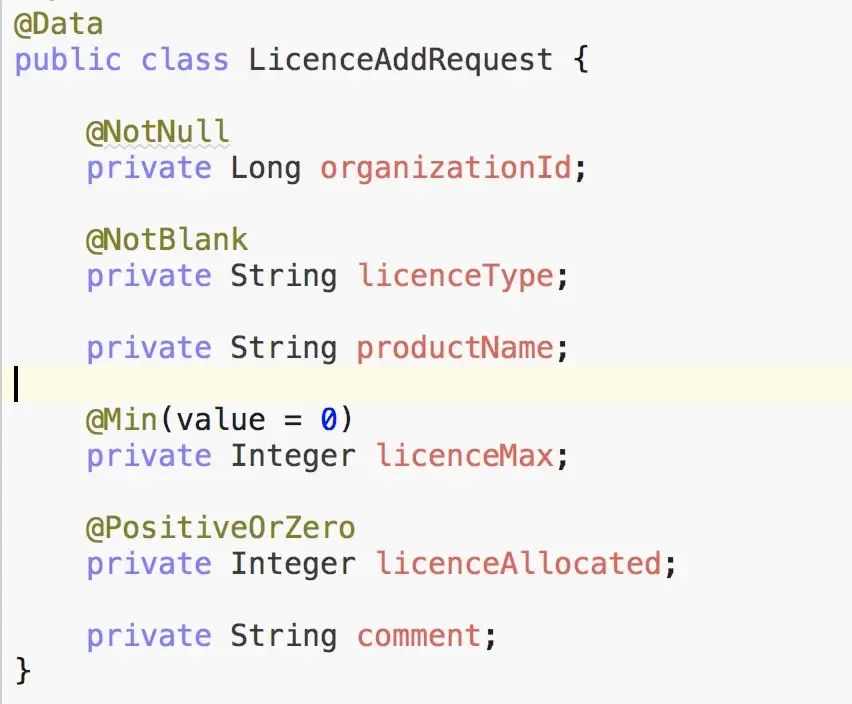
LicenceAddRequest
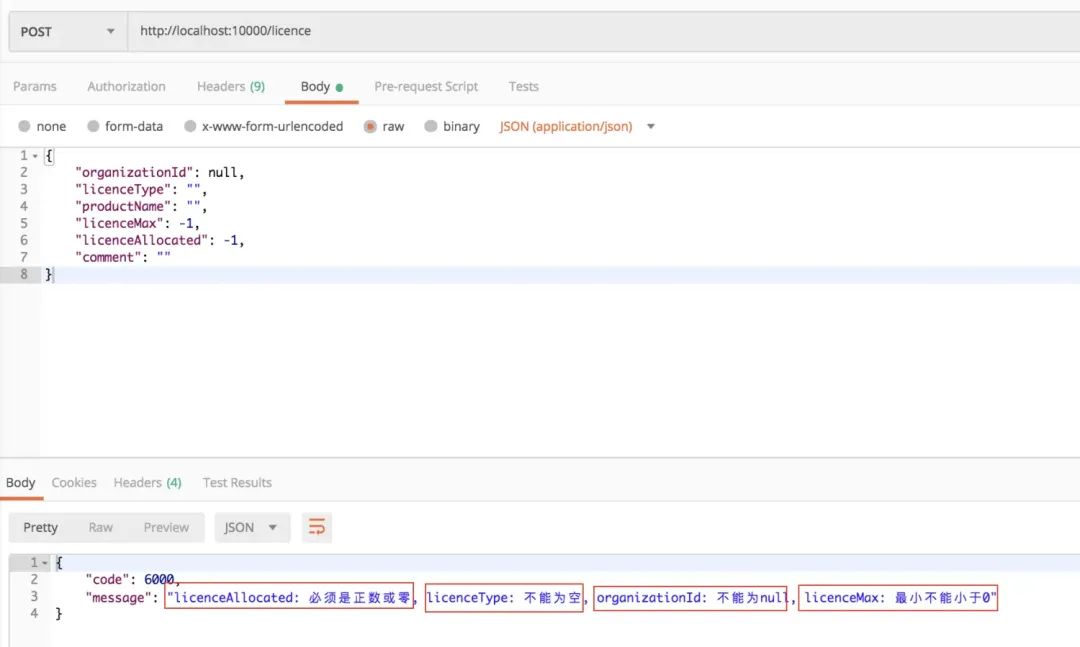
请求url即结果

捕获参数绑定校验异常
注:因为参数绑定校验异常的异常信息的获取方式与其它异常不一样,所以才把这2种情况的异常从 进入 Controller 前的异常 单独拆出来,下面是异常信息的收集逻辑:
异常信息的收集
捕获未知异常
假设我们现在随便对 Licence 新增一个字段 test,但不修改数据库表结构,然后访问:http://localhost:10000/licence/1。
增加test字段
捕获数据库异常

Error querying database
小结
扩展
生产环境返回“网络异常”
可以通过以下方式修改当前环境:
修改当前环境为生产环境
总结
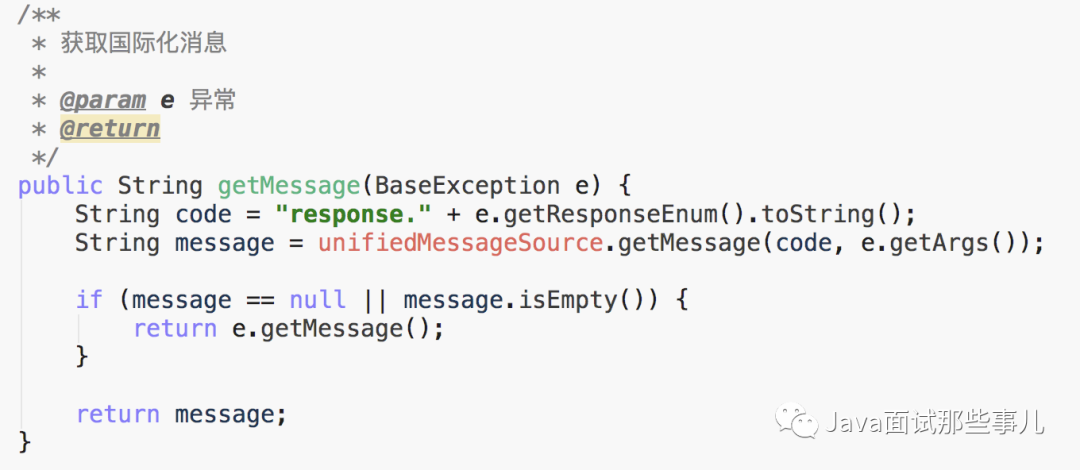
获取国际化消息
最后总结,全局异常属于老生长谈的话题,希望这次通过手机的项目对大家有点指导性的学习。大家根据实际情况自行修改。
也可以采用以下的jsonResult对象的方式进行处理,也贴出来代码.
4jpublic class GlobalExceptionHandler {/*** 没有登录* @param request* @param response* @param e* @return*/(NoLoginException.class)public Object noLoginExceptionHandler(HttpServletRequest request,HttpServletResponse response,Exception e){log.error("[GlobalExceptionHandler][noLoginExceptionHandler] exception",e);JsonResult jsonResult = new JsonResult();jsonResult.setCode(JsonResultCode.NO_LOGIN);jsonResult.setMessage("用户登录失效或者登录超时,请先登录");return jsonResult;}/*** 业务异常* @param request* @param response* @param e* @return*/(ServiceException.class)public Object businessExceptionHandler(HttpServletRequest request,HttpServletResponse response,Exception e){log.error("[GlobalExceptionHandler][businessExceptionHandler] exception",e);JsonResult jsonResult = new JsonResult();jsonResult.setCode(JsonResultCode.FAILURE);jsonResult.setMessage("业务异常,请联系管理员");return jsonResult;}/*** 全局异常处理* @param request* @param response* @param e* @return*/(Exception.class)public Object exceptionHandler(HttpServletRequest request,HttpServletResponse response,Exception e){log.error("[GlobalExceptionHandler][exceptionHandler] exception",e);JsonResult jsonResult = new JsonResult();jsonResult.setCode(JsonResultCode.FAILURE);jsonResult.setMessage("系统错误,请联系管理员");return jsonResult;}}
来源:https://www.jianshu.com/p/3f3d9e8d1efa
最后,关注公众号互联网架构师,在后台回复:2T,可以获取我整理的 Java 系列面试题和答案,非常齐全。
正文结束
推荐阅读 ↓↓↓

正文结束


